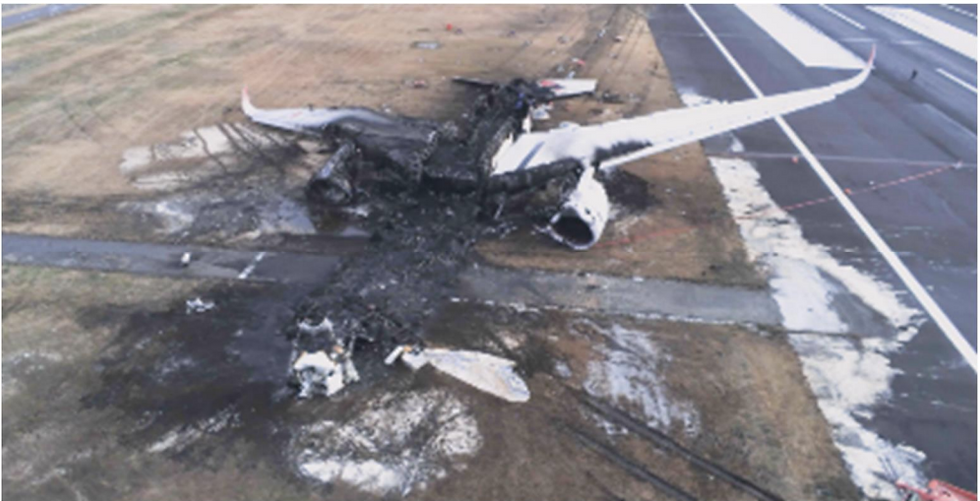Amendment of Japan’s Civil Aeronautics Act in Response to the Haneda Airport Runway Collision
by Shinichiro Tsuri
1. Background
On May 30, 2025, the Japanese Diet passed a bill to partially amend the Civil Aeronautics Act and other related acts, and the revised Civil Aeronautics Act was promulgated on June 6, 2025. One of the key pillars of the amendments is ensuring aviation safety incorporating lessons learned from the tragic accident at Tokyo International Airport (Haneda Airport) on January 2, 2024, which involved a fatal runway collision between a Bombardier DHC-8-315 operated by the Japan Coast Guard (JCG) and an Airbus A350-941 operated by Japan Airlines (JAL). While the root causes of the accident remain under investigation by the Japan Transport Safety Board (JTSB), the amendments were proposed in line with the recommendations outlined in the interim report released in June 2024 by the Haneda Airport Aircraft Collision Prevention Measures Review Committee, established by the Ministry of Land, Infrastructure, Transport and Tourism (MLIT) following the accident. This article provides an overview of this legal amendment prompted by the incident.

JCG’s Aircraft after the Accident
(Image Source: JTSB’s Aircraft Accident Investigation Interim Report )

JAL’s Aircraft after the Accident
(Image Source: JTSB’s Aircraft Accident Investigation Interim Report )
2. Overview of the Amendments for Aviation Safety
Enhancing Runway Safety Measures at Airports
One aspect of the amendments to the Civil Aeronautics Act for aviation safety is enhancement of runway safety. Article 47 was revised to add “measures related preventing runway incursion” to items to be specified in the standards securing the function of aerodrome or air navigation facilities, which their providers must follow. Examples of such measures include the following items, which were mentioned in the recommendations by the Haneda Airport Aircraft Collision Prevention Measures Review Committee.
Establish Runway Safety Teams (which consist of aerodrome operators, ATC provider, aircraft operators, ground handling operators) at major airports (New Chitose, Narita, Haneda, Chubu, Osaka, Kansai, Fukuoka and Naha Airports)
Ensure proper operation of RunWay Status Lights (RWSL) and other facilities
Install location information transmitters on vehicles entering runways
Strengthen the safety supervision system for ground handling (aircraft towing/pushback, cargo loading/unloading, refueling, ramp bus and other auxiliary services) operators

Function of RWSL (warning aircraft waiting on taxiways of other aircraft taking off or landing)
(Image Source: Summary Document of Amendment of the Civil Aeronautics Act )
Mandatory CRM (Crew Resource Management) Training for Pilots
Another aspect of the amendments for aviation safety is mandating CRM training for pilots. According to ICAO Circular 217 “Human Factors Digest No. 2 - Flight Crew Training: Cockpit Resource Management (CRM) and Line-Oriented Flight Training (LOFT),” CRM is defined as “the effective use of all available resources, i.e. equipment, procedures and people, to achieve safe and efficient flight operations.” CRM training focuses on skills such as communication/interpersonal skills, situation awareness, problem-solving/decision-making/judgement, leadership/“followership,” stress management and critique. While CRM training had been already mandatory for pilots of air carriers operating airplanes requiring two or more flight crews, the Haneda Airport Aircraft Collision Prevention Measures Review Committee recommended extending CRM training to all pilots, including private pilots, in order to prevent human errors in air traffic control communication.

Example Situation of CRM
(Image Source: Summary Document of Amendment of the Civil Aeronautics Act )
In accordance with the above recommendation, Article 71-5 was newly added to mandate that all pilots who take off or land at airports in air traffic control zones complete CRM training conducted by a registered training organization. A training organization can be registered by the MLIT when its facilities, equipment, training materials and instructors are found to comply with prescribed requirements. For example, the organization must provide training materials that include scripted scenarios modeled on past incidents such as runway incursions, in which trainees assume the role of the pilot to acquire management skills. The registered training organization must issue a certificate of completion to pilots who have completed their training course, and based on newly added Article 71-6, they must carry this certificate when taking off or landing at airports in air traffic control zones, except as otherwise provided. Article 71-5 and 71-6 will become applicable within three years after promulgation.
3. Conclusion
While the 2025 amendment to Civil Aeronautics Act is a cornerstone for enhancing aviation safety, it will also be essential to establish subordinate legislation and to ensure effective implementation within the legal framework. I hope that the entire aviation industry will fully learn from the lessons of the accident at Haneda Airport and work actively to further improve safety.
References
JTSB, (Aircraft Accident Investigation Interim Report) Japan Coast Guard Bombardier DHC-8-315, JA722A and Japan Airlines Co., Ltd Airbus A350-941, JA13XJ
https://jtsb.mlit.go.jp/eng-air_report/interim20241225-JA722A_JA13XJ.pdf
MLIT, Haneda Airport Aircraft Collision Prevention Measures Review Committee
https://www.mlit.go.jp/koku/koku_tk13_000045.html
MLIT, Cabinet Decision of the “The Bill to Partially Amend the Civil Aeronautics Act and Other Related Acts” ~ Ensuring Aviation Safety and Promoting the Early Restoration of Disaster-Affected Airports ~
https://www.mlit.go.jp/report/press/kouku01_hh_000134.html
Japanese Law Translation, The Bill to Partially Amend the Civil Aeronautics Act and Other Related Acts
https://www.japaneselawtranslation.go.jp/outline/160/905R719.pdf
Cabinet Office, Act to Partially Amend the Civil Aeronautics Act and Other Related Acts
https://www.kanpo.go.jp/20250606/20250606g00125/20250606g001250009f.html
.png)